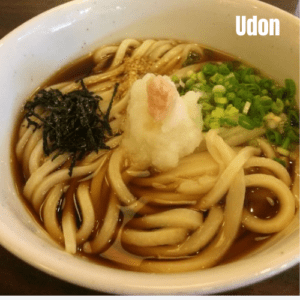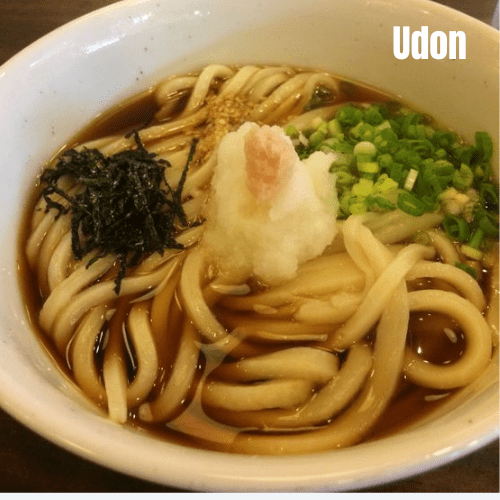Udon noodles, a staple of Japanese cuisine, offer a comforting, chewy texture that pairs perfectly with a variety of broths and toppings. Their versatility makes them a favorite among both casual diners and culinary enthusiasts alike.
Ingredients:
- Fresh Udon noodles
- Dashi stock (or vegetable broth for a vegetarian option)
- Soy sauce
- Mirin (sweet rice wine)
- Toppings such as sliced green onions, tempura flakes, nori seaweed, and kamaboko (fish cake)
Steps
- Boiling the Noodles:
- Begin by bringing a large pot of water to a rolling boil. Carefully add the fresh udon noodles and cook them according to the package instructions, usually about 8-10 minutes or until they are just tender. It’s important not to overcook them to maintain their satisfying chewy texture. Once done, drain the noodles in a colander and rinse them under cold running water to stop the cooking process and remove excess starch.
- Creating the Base:
- While the udon noodles are cooking, prepare the flavorful broth. In a separate pot, combine dashi stock (or vegetable broth for a vegetarian option), soy sauce, and mirin (sweet rice wine) over medium heat. Dashi stock is traditionally made from kombu (dried kelp) and bonito flakes (dried fish flakes), imparting a delicate umami flavor that complements the noodles perfectly. Adjust the seasoning according to your taste preferences, adding more soy sauce for saltiness or mirin for sweetness.
- Assembly Time:
- Once the udon noodles are cooked and drained, divide them evenly among serving bowls. Carefully ladle the hot broth over the noodles, ensuring each bowl is generously filled with the aromatic liquid. The hot broth helps to warm the noodles and infuse them with the rich flavors of the dashi, soy sauce, and mirin.
- Garnishing to Perfection
- With the noodles and broth assembled, it’s time to add the final touches. Top each bowl of udon with sliced green onions for a fresh burst of flavor, tempura flakes (tenkasu) for added crunch, nori seaweed strips for a hint of brininess, and kamaboko (fish cake) slices for a traditional touch. These toppings not only enhance the visual appeal of the dish but also add layers of texture and taste that elevate the udon experience.
Tips for Variation:
- Vegetarian Twist: Replace dashi stock with vegetable broth and enhance the umami with soy sauce and a touch of miso paste.
- Spicy Udon: Add a dash of chili oil or sriracha to the broth for a spicy kick.
- Tempura Udon: Top your udon with crispy tempura shrimp or vegetables for a satisfying crunch.
- Curry Udon: Introduce Japanese curry roux to the broth for a rich and hearty curry udon experience.
- Cold Udon Salad: Rinse cooked udon noodles under cold water after boiling and serve chilled with a sesame dressing, cucumber slices, and shredded chicken or tofu.
- Mushroom Lover’s Udon: Saute mixed mushrooms like shiitake, oyster, and enoki with soy sauce and mirin, then add to your udon and broth for an earthy flavor.
Macros:
- Calories: 200-300 kcal per serving
- Carbohydrates: 40-50g
- Protein: 8-12g
- Fat: 1-3g
Frequently Asked Question for udon
- Are udon noodles gluten-free? No, traditional udon noodles are made from wheat flour and are not gluten-free. However, there are gluten-free alternatives available using rice or buckwheat flour.
- How do I store leftover udon noodles? Store cooked udon noodles separately from the broth in an airtight container in the refrigerator for up to 2 days. Reheat gently in hot broth or stir-fry with vegetables.
- Can I freeze udon noodles? It is not recommended to freeze cooked udon noodles as they can become mushy upon thawing. It’s best to consume them fresh or store them in the refrigerator for short-term use.
- What are some traditional udon toppings? Traditional toppings include tempura flakes (tenkasu), fish cakes (kamaboko), thinly sliced green onions, and dried seaweed (nori). Customize your toppings based on personal preference.
- What is the difference between udon and soba noodles? Udon noodles are thicker and chewier compared to soba noodles, which are made from buckwheat flour and have a nuttier flavor.

Mastering Udon Noodles: A Taste of Japan’s Soulful Delicacy
Udon noodles, a staple of Japanese cuisine, offer a comforting, chewy texture that pairs perfectly with a variety of broths and toppings.
Ingredients
- Fresh Udon noodles
- Dashi stock or vegetable broth for a vegetarian option
- Soy sauce
- Mirin sweet rice wine
- Toppings such as sliced green onions tempura flakes, nori seaweed, and kamaboko (fish cake)
Instructions
Boiling the Noodles:
- Bring a large pot of water to a rolling boil.
- Add fresh udon noodles and cook for 8-10 minutes until tender.
- Drain and rinse noodles under cold water to stop cooking and remove starch.
Creating the Base:
- In a separate pot, combine dashi stock (or vegetable broth), soy sauce, and mirin over medium heat.
- Adjust seasoning to taste with more soy sauce or mirin.
Assembly:
- Divide cooked noodles among serving bowls.
- Ladle hot broth over the noodles.
Garnishing:
- Top with sliced green onions, tempura flakes (tenkasu), nori strips, and kamaboko slices. Enjoy!
